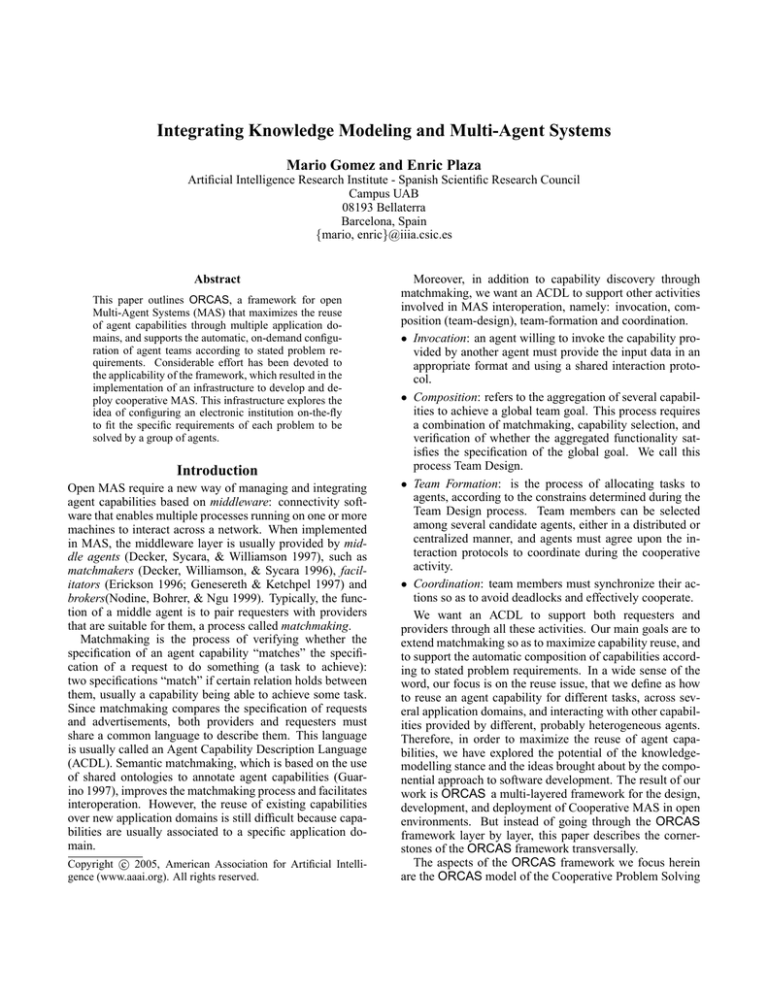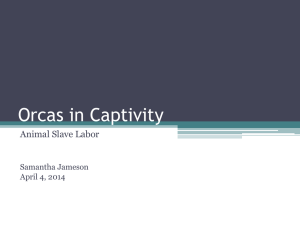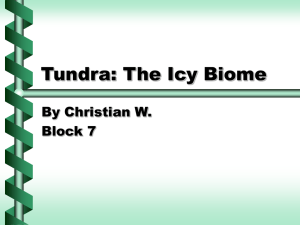
Integrating Knowledge Modeling and Multi-Agent Systems
Mario Gomez and Enric Plaza
Artificial Intelligence Research Institute - Spanish Scientific Research Council
Campus UAB
08193 Bellaterra
Barcelona, Spain
{mario, enric}@iiia.csic.es
Abstract
This paper outlines ORCAS, a framework for open
Multi-Agent Systems (MAS) that maximizes the reuse
of agent capabilities through multiple application domains, and supports the automatic, on-demand configuration of agent teams according to stated problem requirements. Considerable effort has been devoted to
the applicability of the framework, which resulted in the
implementation of an infrastructure to develop and deploy cooperative MAS. This infrastructure explores the
idea of configuring an electronic institution on-the-fly
to fit the specific requirements of each problem to be
solved by a group of agents.
Introduction
Open MAS require a new way of managing and integrating
agent capabilities based on middleware: connectivity software that enables multiple processes running on one or more
machines to interact across a network. When implemented
in MAS, the middleware layer is usually provided by middle agents (Decker, Sycara, & Williamson 1997), such as
matchmakers (Decker, Williamson, & Sycara 1996), facilitators (Erickson 1996; Genesereth & Ketchpel 1997) and
brokers(Nodine, Bohrer, & Ngu 1999). Typically, the function of a middle agent is to pair requesters with providers
that are suitable for them, a process called matchmaking.
Matchmaking is the process of verifying whether the
specification of an agent capability “matches” the specification of a request to do something (a task to achieve):
two specifications “match” if certain relation holds between
them, usually a capability being able to achieve some task.
Since matchmaking compares the specification of requests
and advertisements, both providers and requesters must
share a common language to describe them. This language
is usually called an Agent Capability Description Language
(ACDL). Semantic matchmaking, which is based on the use
of shared ontologies to annotate agent capabilities (Guarino 1997), improves the matchmaking process and facilitates
interoperation. However, the reuse of existing capabilities
over new application domains is still difficult because capabilities are usually associated to a specific application domain.
c 2005, American Association for Artificial IntelliCopyright °
gence (www.aaai.org). All rights reserved.
Moreover, in addition to capability discovery through
matchmaking, we want an ACDL to support other activities
involved in MAS interoperation, namely: invocation, composition (team-design), team-formation and coordination.
• Invocation: an agent willing to invoke the capability provided by another agent must provide the input data in an
appropriate format and using a shared interaction protocol.
• Composition: refers to the aggregation of several capabilities to achieve a global team goal. This process requires
a combination of matchmaking, capability selection, and
verification of whether the aggregated functionality satisfies the specification of the global goal. We call this
process Team Design.
• Team Formation: is the process of allocating tasks to
agents, according to the constrains determined during the
Team Design process. Team members can be selected
among several candidate agents, either in a distributed or
centralized manner, and agents must agree upon the interaction protocols to coordinate during the cooperative
activity.
• Coordination: team members must synchronize their actions so as to avoid deadlocks and effectively cooperate.
We want an ACDL to support both requesters and
providers through all these activities. Our main goals are to
extend matchmaking so as to maximize capability reuse, and
to support the automatic composition of capabilities according to stated problem requirements. In a wide sense of the
word, our focus is on the reuse issue, that we define as how
to reuse an agent capability for different tasks, across several application domains, and interacting with other capabilities provided by different, probably heterogeneous agents.
Therefore, in order to maximize the reuse of agent capabilities, we have explored the potential of the knowledgemodelling stance and the ideas brought about by the componential approach to software development. The result of our
work is ORCAS a multi-layered framework for the design,
development, and deployment of Cooperative MAS in open
environments. But instead of going through the ORCAS
framework layer by layer, this paper describes the cornerstones of the ORCAS framework transversally.
The aspects of the ORCAS framework we focus herein
are the ORCAS model of the Cooperative Problem Solving
(CPS) process, and the ORCAS Agent Capability Description Language (ACDL).
Overview of the ORCAS framework
This section provides an overall view of the framework
and reviews the most important concepts needed to understand the other sections. The reader is referred to (Gómez
2004) for a complete, detailed description of the framework.
ORCAS has three layers, namely: the Knowledge Modelling Framework, the Operational Framework and the Institutional Framework:
1. The Knowledge Modelling Framework (KMF) proposes
a conceptual and architectural description of problemsolving systems from a knowledge-level view, abstracting the specification of components from implementation
details. In addition, the KMF incorporates a bottom-up
design process to configure a system out of elementary
components, until a system configuration is found that
satisfies some global requirements. This process is used
to design the organization of a team and the competence
required for each team role during the problem-solving
process.
2. The Operational Framework deals with the link between
the specification of components in the KMF, and the operational aspects of Multi-Agent Systems. This framework
comprehends an extension of the KMF to obtain a fullfledged Agent Capability Description Language, together
with a new model of the Cooperative Problem Solving
process that includes a Team Design stage prior to the
Team Formation stage.
3. The Institutional Framework describes an implemented
infrastructure for developing and deploying Multi-Agent
Systems configurable on-demand, according to the the requirements of the problem at hand.
Figure 1: The three layers of the ORCAS framework
Figure 1 shows the three layers as a pyramid made of three
blocks. The block at the bottom corresponds to the more
abstract layer, while upper blocks corresponds to increasingly implementation dependent layers. Therefore, developers and system engineers can decide to use only a portion of
the framework, starting from the bottom, and modifying or
changing the other frameworks according to its preferences
and needs.
Figure 2: The ORCAS Abstract Architecture
Knowledge Modelling Framework
The ORCAS Knowledge Modelling Framework (KMF)
proposes a conceptual description of Multi-Agent Systems
at the knowledge level (Newell 1982), abstracting the specification of components from implementation details. The
purpose of the Knowledge Modelling Framework (KMF) is
twofold: on the one hand, the KMF is a conceptual tool to
guide developers in the analysis and design of Multi-Agent
Systems in a way that maximizes capability reuse across different domains; on the other hand, the KMF provides the basis for an Agent Capability Description Language (ACDL)
supporting the automatic, on-demand configuration of agent
teams according to stated problem requirements.
The ORCAS KMF is based on the Task-Method-Domain
(TDM) paradigm prevailing in existing Knowledge Modelling frameworks. This paradigm distinguishes between
three classes of components: tasks, problem-solving methods (PSM) and domain models. In ORCAS there are tasks
and domain models, while PSMs are replaced by agent capabilities, playing the same role as PSMs, but including agent
specific features concerning communication and coordination. Adopting this KMF we expect the ORCAS Abstract
Architecture to provide an effective organization for constructing libraries with large “horizontal cover” (Breuker &
Van de Velde 1994; Valente, Van de Velde, & Breuker 1994;
Motta 1999), thus maximizing reusability and avoiding the
brittleness of monolithic libraries (Motta et al. 1999).
A task is a functional description of a type of problem
to be solved. A task is functionally characterized by input
roles, output roles, and the relationship between them, which
is specified as a set of preconditions and postconditions.
A capability describes a particular method for solving
problems with some specific properties. A capability is
specified from a functional viewpoint by stating the input
roles, output roles, preconditions and posconditions. In addition, a capability can specify the type of domain knowledge (knowledge-roles) it requires, and some properties that
have to be fulfilled by the domain knowledge to sensibly apply that capability (assumptions).
There are two types of capability: task-decomposer and
skill. While skills are used to describe primitive, atomic reasoning steps, task-decomposers are used to describe complex reasoning methods that decompose a problem into sev-
eral subtasks.
Finally, a domain model (DM) specifies the concepts, relations and properties characterizing the knowledge from
certain application domain.
The ORCAS KMF extends matchmaking in two ways
(Gómez & Plaza 2004): first, in addition to provide its own
version of a task-capability matching, ORCAS introduces a
capability-domain matching to decide whether a capability
is suitable to be applied over certain application domain; and
second, ORCAS addresses the composition of capabilities
on-demand, according to the requirements of the problem at
hand.
We regard the composition of capabilities as a “bottom-up
design problem”(Hafedh Mili & Mili 1995), which in agent
terms would be rewritten as: given a set of requirements,
find a set of agent capabilities whose combined competence
and available knowledge satisfies those requirements. The
main difficulty to solve that problem is how to decompose
the requirements in such a way as to yield component specifications. Our approach to this problem is to use a search
process over the space of possible configurations. In ORCAS, the bottom-up design process is called Team Design,
and the result is a task-configuration, a hierarchical decomposition of a task into subtasks, and capabilities bound to
tasks according to matching relations, in such a way that the
resulting task-configuration satisfies the global problem requirements.
Task
Information search
Metasearch
Elaborate
Query
Customize
Query
Query-expansionwith-thesaurus
MeSH
(Thesaurus)
QueryCustomization
Source
Descritpions
Institutional Framework
Domain-model
An electronic institution (e-Institution), is a “virtual place”
designed to support and facilitate certain goals to the human
and software agents concurring to that place (Noriega 1997;
Rodrı́guez-Aguilar 1997). Since these goals are achieved by
means of the interaction of agents, an e-institution provides
the social mediation layer required to achieve a successful
interaction: interaction protocols, shared ontologies, communication languages and social behavior rules.
The ORCAS Institutional Framework devises a institutional model covering all the stages of the ORCAS Cooperative Problem Solving process: the ORCAS e-Institution,
a platform for developing and deploying cooperative MAS
that supports both providers and requesters of capabilities
along the different stages of the ORCAS model of the CPS
process.
The e-Institutions formalism was originally conceived to
deal with static organizations encompassing a fixed role
structure and fixed interaction protocols, while the ORCAS
institutional framework (both conceptually and in the implemented agent platform) is an electronic institution that allows other institutions to be configured on-the fly. The point
is that in the ORCAS platform, each team formed to solve
a problem implies that a new electronic institution is composed on demand out of the interaction protocols agents are
equipped with, and that institution is used as the social mediation layer required by team members to effectively communicate and coordinate during the CPS activity.
Aggregate
Aggregation
Retrieval
AggregateItems
ElaborateItems
Items-Elaboration
The Operational Framework describes a mapping from concepts in the Knowledge-Modelling Framework to concepts
from Multi-Agent Systems. Specifically, the Operational
Framework describes how a composition of capabilities represented at the knowledge-level can be operationalized by a
customized team of agents; in other words, how to form a
team of agents able to carry on the execution of a particular composition of capabilities, over a particular application
domain.
The Operational Framework proposes a hierarchical
model of teamwork that is straightforwardly derived from
the hierarchical decomposition of tasks into subtasks that is
the backbone of the TDM paradigm. This model of teamwork is embedded within a complete model of the Cooperative Problem Solving process that covers all the stages, from
the specification of a problem to be solved to the activities
carried on by agents willing to solve it.
In order to effectively use a KMF in open agent environments, a capability description language should include
some way of specifying the communication and the coordination mechanisms required by agents to cooperate. Our
approach to describe such aspects of a capability is based on
the macro-level (societal) aspects of agent societies, which
is focused on the communication and the observable behavior of agents, rather than adopting a micro-level (internal)
view on individual agents. In particular, we are using concepts from the electronic institutions formalism to describe
such aspects, as explained in the next section.
Task decomposer
Skill
Retrieve
Operational Framework
Arithmetic-Mean
Figure 3: Task-configuration example
Figure 3 shows an example of a task-configuration for the
Information-Search task, which is used within the WIM
application. This task is being decomposed into four tasks
by the Meta-search task-decomposer: Elaborate-query,
Customize-query, Retrieve and Aggregate, which is further decomposed by the Aggregation capability in two subtasks: Elaborate-items and Aggregate-items. The example shows some skills requiring domain knowledge, e.g.
the Query-expansion-with-thesaurus requires a thesaurus
(e.g. MeSH, a medical thesaurus), and the Retrieval and
Query-customization skills require a description of information sources.
The integration of the knowledge-modelling stance and
the electronic institutions formalism within the ORCAS eInstitution favors the development of highly configurable
and reusable MAS in open environments.
Remark that in addition to implement an agent infrastructure using the electronic institutions formalism, we are using the concepts proposed by the e-Institutions approach to
specify the communication and coordination mechanisms of
individual agents.
In order to demonstrate the applicability of the ORCAS
framework, we have built WIM, a MAS-based configurable
application to search bibliographic information in the Internet (Gómez & Abasolo 2003; Gómez 2004). WIM is
an e-Institution that results of linking a library of information search and aggregation (ISA) capabilities provided by
agents, and domain knowledge from medicine, and more
specifically, Evidence-Based Medicine (EBM). Figure 4
outlines the architecture of the WIM application. The ORCAS e-Institution provides the mediation service for agents
to communicate and cooperate. The institution provides a
yellow pages service (through a librarian agent) where problem solving agents register their capabilities. The capabilities in the library are link to some domain models characterizing the application domain (EBM). User requests to perform search tasks solve problem are received through a Personal Assistant agent that expresses them using the ISA ontology. This agent acts as mediator between the user and the
institutional agents providing the services required to carry
on the CPS process: to find a valid task-configuration (Team
Design), to allocate tasks to agents (Team Formation), and to
coordinate individual agent behaviors to achieve the global
task cooperatively(Teamwork). The figure depicts also the
existence of wrappers, ad-hoc elements that are used to
agentify external information sources, making them accessible to agents.
Figure 4: Task-configuration example
The ORCAS model of the Cooperative
Problem-Solving process
Most of the research done in the field of cooperative MAS
fits into one or more or the stages of the Cooperative
Problem-Solving process as presented in (Wooldridge &
Jennings 1994), which consists of four stages: recognition,
team formation, planning and execution.
Although the proposers of this model believe many instances of the CPS process exhibit these stages in some form
(either explicitly or implicitly), they stress that the model is
idealized. In other words, there are cases that the model cannot account for (Wooldridge & Jennings 1999). Since team
formation is not guided by a preplan to achieve the overall
goal, but is just a commitment to joint action, then neither
the agents joining a team (committing to carry on joint action) are guaranteed to play one role in the team once a plan
was decided at the subsequent planning stage, nor the resulting team assures that a global plan can be found.
The SharedPlans theory (Grosz & Kraus 1996) and the
frameworks based on it, e.g. (Giampapa & Sycara 2002),
have emphasized the need for a common, high-level team
model that allows agents to understand the requirements to
achieve a global team goal and select a plan. Team plans
are used by agents to acquire goals, to identify roles and to
relate individual goals to team goals. A plan allows the initiator of the team formation process to know which are the
subgoals and (optionally) the actions or capabilities required
to achieve each subgoal. Therefore, the initiator of a CPS
process can use an initial plan to guide the team formation
process (Tidhar, Rao, & Sonenberg 1996). However, there
is still another limitation of most planning frameworks used
in real, implemented MAS: plans are tightly bound to a very
specific domain and generic tasks. Consequently, plans are
hardly reusable for different domains, and cannot be adapted
to fit specific requirements of the problem at hand (e.g. different users may prefer different ways of achieving a task,
and thus different capabilities may be preferable depending
on the user preferences).
Finally, most planning-based MAS devise an internal perspective of agents, whose internal state is used as the basis
for evaluating the cooperative behavior. Concerning this issue, though we recognize there are well founded reasons to
adopt an internal perspective in several contexts, we think
a external view has some notable advantages under certain
circumstances; in particular, it is more appropriate for open
systems because it avoids imposing a model of the internal
agent architecture to external agent developers.
Summing up, we address some requirements for developing Cooperative MAS in open environments that are not
entirely covered by previous models of the CPS process: (1)
the need for initial plans to guide the team formation process; (2) the consideration of the user preferences and specific problem requirements as a constrain over the competence of a team; and (3) an external view centered on observable events, rather than an internal view imposing a particular agent architecture.
As a result of our work upon these issues we have conceived a new model of the CPS process with four subprocesses (Figure 5), namely Problem Specification, Team
Design, Team Formation and Teamwork.
The Problem Specification process produces a specification of problem requirements to be met by a team, including a description of the application domain (a collection of
Figure 6: Main features of the ORCAS ACDL
Figure 5: Overview of the ORCAS Cooperative Problem
Solving process.
domain models) and the problem data to be used during the
Teamwork process. The Team Design process uses the problem requirements to build a task-configuration —a composition of tasks, capabilities and domain models. The resulting
task-configuration is used during the Team Formation process to allocate tasks and subtasks to agents, and instruct
agents to ensure that the requirements of the problem are
achievable. Finally, during the Teamwork process, team
members try to solve the problem cooperatively, following
the instructions received during Team Formation, and thus
complying with the specific requirements of the problem at
hand .
The ORCAS model of the CPS process should not be understood as a fixed sequence of steps. Actually, we have implemented strategies that interleave Team Design and Team
Formation with Teamwork, thus enabling distributed configuration, lazy configuration and dynamic reconfiguration
of teams on runtime(Gómez 2004).
The ORCAS Agent Capability Description
Language
The functional description of a capability as provided in the
Knowledge-Modelling Framework enables the automated
discovery and the composition of capabilities, without taking into account communication and coordination requirements. Nonetheless, the invocation of capabilities and the
interoperation of multiple agents are not supported by the
functional description of a capability. In order to deal with
these activities, we have to include information concerning
the communication requirements of an agent over the capabilities he provides, and the operational description(control
and data flow) of tasks-decomposers . Figure 6 shows the
main concepts specifiable in the ORCAS ACDL.
In ORCAS, both the communication and the operational
description of a capability are described using concepts from
the electronic institutions formalism (Esteva et al. 2001),
which adopts an external view on agents. Specifically, ORCAS uses scenes to describe the communication requirements of an agent over a particular capability, and performative structures to specify the operational description of a
task-decomposer. Since we are using those concepts in a
new way, a brief review of the electronic institutions concepts used in ORCAS is pertinent now:
1. Agent roles: Agents are the players in an electronic
institution, interacting by the exchange of speech acts,
whereas roles are standardized patterns of behavior required by agents playing part in given functional relationships.
2. Dialogic framework: A dialogic framework determines
the valid illocutions that can be exchanged among the
agents participating in an electronic institution, which involves a vocabulary (ontology) and some agent communication language (ACL).
3. Communication scenes: A scene defines an interaction
protocol among a set of agent roles, and using some dialogic framework.
4. Performative structure: A performative structure is a network of connected scenes that captures the relationships
among scenes. A performative structure constrains the
paths agents can traverse to move from one scene to another, depending on the roles they are playing.
Communication
Agent capabilities should be specified independently of
other agents in order to maximize their reuse and facilitate
their specification by third party agent developers. In the
general case, agent developers do not know a priori the tasks
that could be achieved by a particular capability, neither the
domains they could be applied to. As a consequence, the
team roles an agent could play using a capability are not
known in advance, thus the scenes used to specify the communication requirements of an agent over certain capability cannot be specified in terms of specific team-roles, but
in terms of abstract, generic problem solving roles. Since
ORCAS teams are designed in terms of a hierarchical decomposition of tasks into subtasks, then teamwork in ORCAS is straightforwardly organized as a hierarchy of teamroles. Some positions within a team (team-roles) are bound
to a task-decomposer, thus the agents playing those teamroles are responsible of delegating subtasks to other agents,
receiving the results, and performing intermediate data processing between subtasks. In such an scenario, we can establish an abstract communication model with two basic roles:
coordinator, which is adopted by an agent willing to decompose a task into subtasks, and operator, which is adopted by
the agent having to perform a task on demand, using the data
provided by another agent that acts as coordinator of a toplevel task





